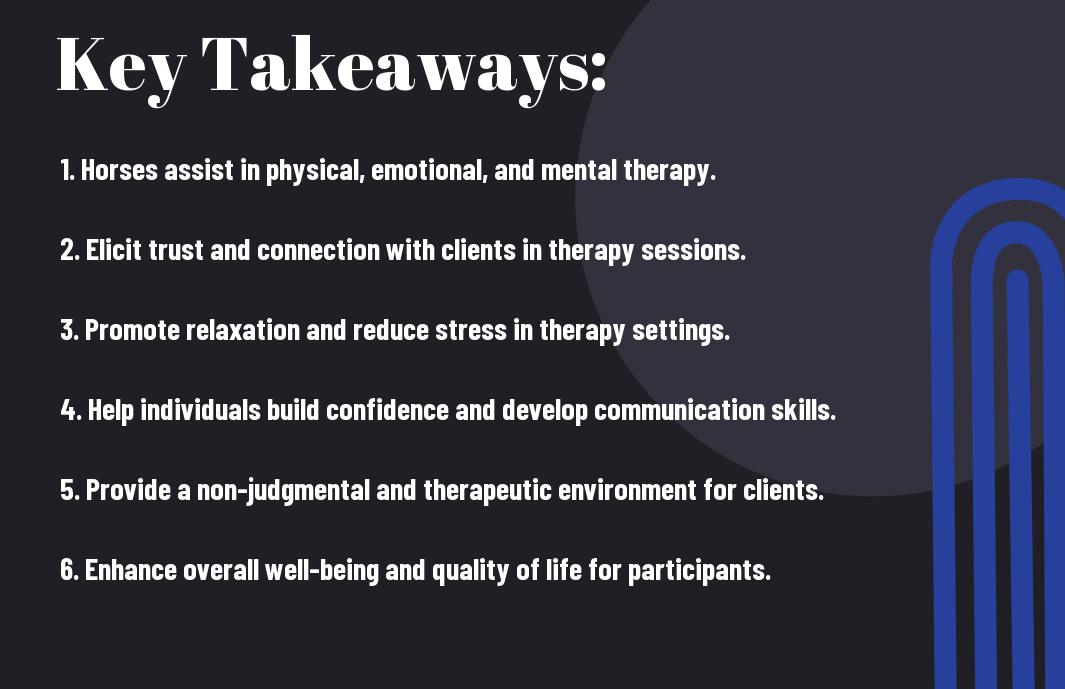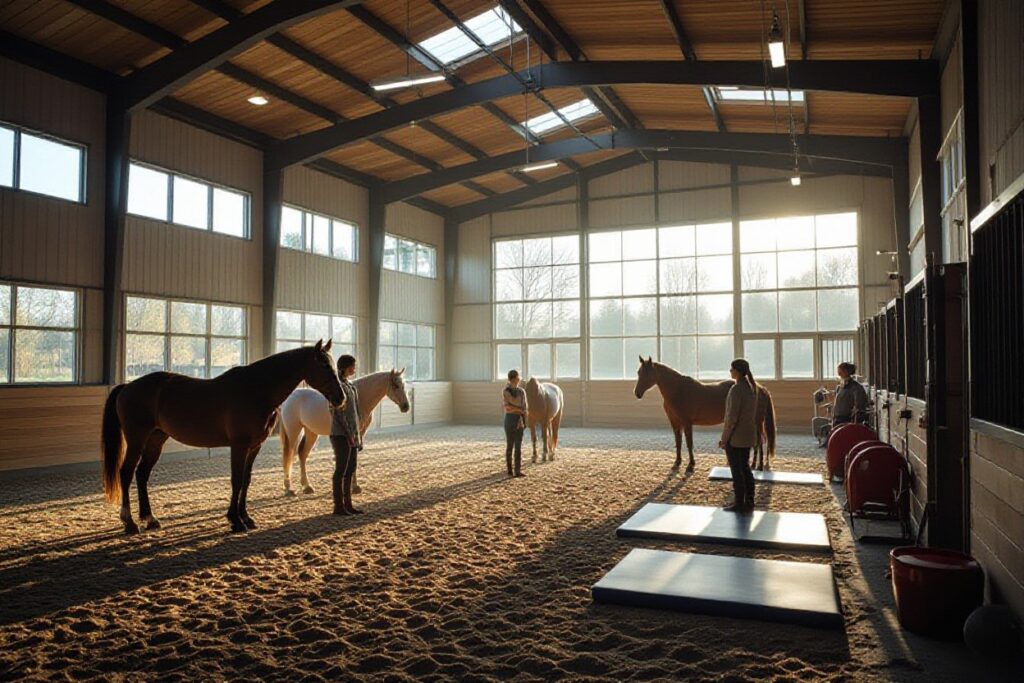Equine therapy, using horses to provide emotional healing and mental health benefits, has gained recognition in modern therapy practices. Discover the transformative power of interacting with these majestic creatures and how they can aid in building confidence, developing trust, and improving communication skills in individuals of all ages. Explore how horses can be mirrors to our emotions and help us on our journey to self-discovery and healing.

History of Equine-Assisted Therapy
Ancient Roots
Therapy involving horses dates back thousands of years, with ancient civilizations such as the Greeks, Romans, and Mongols recognizing the healing power of these majestic creatures. In ancient Greece, horses were believed to possess divine powers and were used in therapeutic practices to promote physical and mental well-being. The Romans also saw the benefits of equine-assisted therapy, using horses in rehabilitation exercises for injured soldiers.
Modern Developments
Ancient wisdom paved the way for the development of modern equine-assisted therapy techniques. In the 20th century, therapeutic horseback riding became popular as a treatment for individuals with physical disabilities. This marked the beginning of a new era in equine therapy, with horses being utilized to help individuals with various mental health challenges such as PTSD, anxiety, and depression.
Developments in equine-assisted therapy continue to gain recognition and acceptance in modern healthcare practices. The unique bond between humans and horses, combined with the gentle yet powerful nature of these animals, offers a safe and effective therapeutic experience for individuals facing emotional or psychological struggles.

The Science Behind Horse-Human Bonding
Little is known about the deep connection between horses and humans, but recent scientific studies have shed light on the bond formed between the two species. One key element in this connection is the release of oxytocin, often referred to as the “love hormone”, which is produced in both humans and horses during positive interactions.
Oxytocin and Trust
On a chemical level, oxytocin plays a crucial role in developing trust and bonding between individuals. When you spend time with a horse, especially engaging in activities such as grooming or riding, both you and the horse experience an increase in oxytocin levels. This hormonal surge fosters a sense of trust and connection, strengthening the bond between you and your equine companion.
Mirroring and Empathy
Behind the scenes of horse-human bonding lies the concept of mirroring and empathy. Horses are highly attuned to human emotions and can mirror your feelings effortlessly. When you approach a horse with a calm and open demeanor, the horse is likely to respond in kind, reflecting your emotions back to you. This mirroring effect promotes empathy and emotional understanding, creating a profound connection between you and the horse.
Science: Understanding the science behind mirroring and empathy can deepen your appreciation for the emotional dynamics at play in horse-human relationships. By recognizing how horses respond to your emotions and mirror your actions, you can cultivate a deeper sense of empathy and connection with these magnificent animals.
Sensory Experiences
Empathy is a two-way street in horse-human bonding, with sensory experiences playing a significant role in fostering connection. Horses are incredibly sensitive animals, attuned to subtle cues and non-verbal communication. When you interact with a horse, your sensory experiences – such as touch, sight, and sound – communicate your emotions and intentions, allowing the horse to respond in kind.
Experiences: Your sensory interactions with horses can be powerful tools for building trust and deepening your connection. By paying attention to your senses and how they influence your interactions with horses, you can enhance the emotional bond you share, creating a meaningful and enriching therapeutic experience.
Therapeutic Benefits of Horse Interaction
Emotional Healing
Your interactions with horses can have profound emotional healing benefits. Being around horses can help you reduce stress, build confidence, develop patience, and enhance self-awareness. Horses are incredibly sensitive animals that can pick up on your emotions, providing you with honest feedback without judgment.
Physical Rehabilitation
Any physical interaction with horses can contribute to your physical rehabilitation. Engaging in activities such as grooming, walking, or riding can improve your motor skills, balance, and muscle strength. Additionally, the rhythmic movement of the horse’s gait can aid in improving your coordination and flexibility.
The physical benefits of horse therapy are enhanced by the warmth and gentle nature of the animals. Their calm presence can help you relax and engage muscles that may be difficult to target in traditional rehabilitation settings.
Social Skills Development
With guidance from skilled therapists, interacting with horses can help you develop important social skills. Working with horses in a team can improve your communication skills, boost your empathy, and enhance your ability to trust others. Horses are non-judgmental beings that can help you practice forming relationships in a safe environment.
Another key aspect of social skills development during horse therapy is learning to set boundaries. Horses respond to clear, consistent cues, teaching you the importance of communication and establishing limits in social interactions.
Types of Equine-Assisted Therapies
Despite the various types of equine-assisted therapies, each has its unique benefits and applications. Here are the different types of therapies that involve horses:
| Equine-Assisted Psychotherapy (EAP) | Equine-Assisted Learning (EAL) |
| Therapeutic Riding (TR) |
Equine-Assisted Psychotherapy (EAP)
On your journey to healing and self-discovery, Equine-Assisted Psychotherapy (EAP) can play a crucial role. In this therapy, you engage in various activities with horses under the guidance of a licensed therapist. The interaction with horses can help you explore and address emotional issues, improve communication skills, and build trust and empathy.
Equine-Assisted Learning (EAL)
One way to enhance your personal growth and development is through Equine-Assisted Learning (EAL). By participating in activities with horses, you can learn important life skills such as leadership, teamwork, problem-solving, and effective communication. The intuitive nature of horses can provide valuable feedback, helping you gain insights and make positive changes in your life.
Therapeutic Riding (TR)
Riding therapies involve structured horseback riding sessions led by certified instructors. These sessions are designed to improve your physical, emotional, and cognitive well-being. Therapeutic Riding can help enhance your balance, coordination, muscle strength, and confidence. Additionally, the bond formed between you and the horse can boost your self-esteem and sense of achievement.

The Role of Horses in Mental Health Treatment
Anxiety and Depression
Not only are horses majestic creatures, but they also play a crucial role in mental health treatment, particularly in alleviating symptoms of anxiety and depression. The gentle and non-judgmental nature of horses creates a safe environment for individuals to connect, build trust, and work through their emotions.
Post-Traumatic Stress Disorder (PTSD)
To address the emotional scars of trauma, horses offer a unique form of therapy for individuals dealing with Post-Traumatic Stress Disorder (PTSD). Interacting with these sensitive animals can help individuals process and release emotions tied to their traumatic experiences. The strong yet calming presence of horses can provide comfort and support in moments of distress.
For instance, when working with individuals with PTSD, horses can sense subtle changes in mood and behavior, offering cues for therapists to address underlying issues. This intuitive interaction between horses and individuals can lead to breakthroughs in therapy sessions, promoting healing and growth.
Autism Spectrum Disorder (ASD)
Disorder
Individuals with Autism Spectrum Disorder (ASD) often benefit from equine therapy due to the structured and rhythmic nature of interactions with horses. These predictable interactions can help individuals with ASD develop social skills, improve communication, and regulate their emotions.
Disorder

Challenges and Limitations of Equine-Assisted Therapy
Accessibility and Cost
Keep in mind that accessing equine-assisted therapy can sometimes be challenging due to location and cost. Therapeutic horseback riding centers may not be widely available, especially in rural areas. Additionally, the expense of maintaining horses, staff, and facilities can make sessions costly for some individuals or families.
Training and Certification
Training to become a certified equine-assisted therapist requires dedication and specialized education. You must undergo specific training programs that combine knowledge of therapy techniques with understanding horse behavior and care. Certification processes can vary, so it’s vital to research recognized programs and ensure you meet the necessary requirements.
A certified equine-assisted therapist has a deep understanding of both human psychology and horse behavior. This dual expertise allows them to create safe and effective therapy environments that benefit both the client and the horse.
Safety Concerns
Concerns about safety in equine-assisted therapy should not be taken lightly. While horses are incredibly intuitive animals and can form strong bonds with humans, they are still large, powerful creatures. It’s crucial to follow safety protocols, always be aware of your surroundings, and ensure that both clients and horses are comfortable and protected during sessions.
The well-being of both the client and the horse should always be the top priority in equine-assisted therapy. **Strong communication** between therapists, clients, and staff, as well as a thorough understanding of horse behavior, can help mitigate potential risks and ensure a safe and positive therapeutic experience.
Summing up
Considering all points, it is evident that horses play a crucial role in modern therapy, offering unique emotional, physical, and mental benefits to individuals. Through their gentle nature and intuitive connection with humans, these majestic creatures have become invaluable partners in therapeutic interventions for various conditions.
Whether you are seeking relief from stress, building confidence, or improving your physical well-being, the bond between horses and humans can provide a safe and nurturing environment for growth and healing. The role of horses in modern therapy serves as a reminder of the powerful connection between animals and humans, showcasing the transformative impact they can have on our well-being.
Q: What is equine therapy?
A: Equine therapy, also known as horse therapy or hippotherapy, is a form of therapy that involves interactions between patients and horses to promote emotional growth, mental health, and physical well-being.
Q: What are the benefits of incorporating horses into therapy?
A: The benefits of incorporating horses into therapy include improved social skills, increased self-esteem and self-awareness, decreased anxiety and stress, and enhanced emotional regulation.
Q: What conditions can be treated with equine therapy?
A: Equine therapy has been used to treat a variety of conditions, including post-traumatic stress disorder (PTSD), anxiety, depression, autism spectrum disorders, and physical disabilities.
Q: Who can benefit from participating in equine therapy?
A: People of all ages can benefit from participating in equine therapy, including children, adolescents, adults, and seniors. It is particularly beneficial for individuals who may have struggled with traditional forms of therapy.
Q: How are horses able to help in therapy sessions?
A: Horses are highly intuitive animals that can pick up on human emotions and provide immediate feedback to clients. They can help individuals build trust, improve communication skills, and learn valuable coping strategies.











